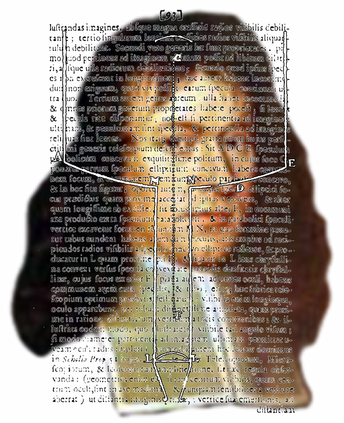James Gregory1638–1675
Optics was an essential science in the seventeenth century because of its importance to the uses of lenses and mirrors. Lenses could assist vision in the elderly as well as being parts of the optical instruments that magnified minute and distant features that could not be seen by the naked eye. Galileo’s telescope opened up the heavens for closer scrutiny by the human eye, but other models were in the making. Gregory described a reflecting telescope in his book Optica Promota published in 1663. His portrait is combined with the diagram of the instrument, taken from the book, as well as the text describing it. A translation of Gregory’s Optica Promota can be found at: www.17centurymaths.com
He described the telescope as follows: “Let AFCE be a concave parabolic mirror most carefully polished, in the focus C of which is placed a small concave elliptical mirror having a common focus, and a common axes with the concave parabolic mirror, and may be fastened in this position; but it is necessary that the preceding focus of this elliptic mirror shall approach as close as possible to its vertex, and the other focus shall be the greatest distance from this vertex; the other focus of this elliptic mirror shall be F, with a common axis produced beyond the parabolic mirror, and in the vertex of the of the parabolic mirror a round hole MN is hollowed out, in which hole a tube is placed having the same axis as the mirrors, big enough to be receiving the reflected rays of the visible object from the concave elliptic mirror, and the tube is produced to L, which is close to F itself, and a crystalline lens is attached at L, of which F is the outer focus, but planar in the direction of the eye, having a common axis with the mirrors and tube. And this will be best resolved telescope made for far vision, indeed remote visible objects will appear to the eye through the tube most distinctly enlarged, which is almost in the ratio of the distances of the vertices from the common foci; and made clear in the same way by which vision may be may be explained for such a visual angle.” Gregory stated that he could not construct such an instrument himself, but it is considered to have provided the inspiration for Newton to make his reflecting telescope some years later, although it was generally referred to as a Gregorian telescope. Gregory was born near Aberdeen and studied there before travelling to London and Padua. He held chairs in mathematics and astronomy at St Andrews and then Edinburgh Universities. He corresponded with Newton on mathematics before Gregory’s untimely death at the age of 37.
